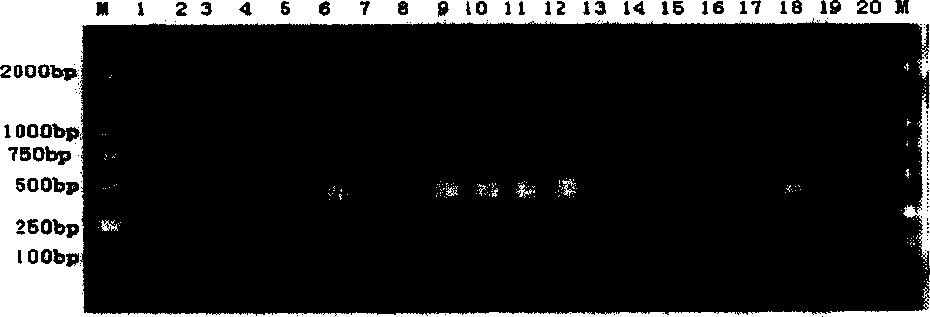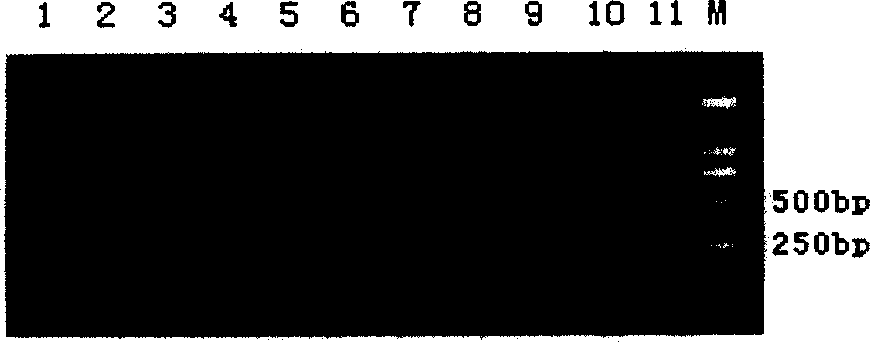Detecting gene of bacillus anthracis anticarbendazol and its reagent box
A technology of carbendazim and anthrax bacteria, which is applied in the detection of anthrax bacteria and physiological races of plant pathogens, can solve the problems of limited number of samples, heavy workload, and difficult-to-drug-resistant physiological races, and achieve easy-to-step The effect of operation, simple steps, high accuracy and sensitivity
- Summary
- Abstract
- Description
- Claims
- Application Information
AI Technical Summary
Problems solved by technology
Method used
Image
Examples
Embodiment 1
[0033] Embodiment 1: PCR amplification of specific primers CGS2 / CGrev and CGS2 / CGrev of anthracnose bacteria (Colletotrichum gloeosporiodies) in Yancheng, Jiangsu Province:
[0034] In 2001, 70 anthracnose (Colletotrichum gloeosporiodies) strains were obtained by collecting capsicum anthracnose fruits from Yancheng, Jiangsu Province. According to the mutation study of the 198-position amino acid codon of β-tubulin in the carbendazim-resistant strain of plant pathogenic filamentous fungi, a degenerate primer B1 / B3 [B1: 5'-A(AG)AT(CT)ACCCA( CT)TC(CT)CT(CT)GGTGGTGG-3', B3: 5'-CTCCAT(CT)TC(AG)TCCAT(ACT)CC(CT)TC(AG)CC-3'], amplified respectively For the anthrax bacteria with carbendazim sensitivity and resistance, a PCR product with a length of about 600bp was obtained. The PCR product was directly sequenced with primers to obtain a 586bp fragment.
[0035] DNAclub molecular biology software was used to compare the homology of the obtained sequence with the reported sequence in t...
Embodiment 2
[0042] Embodiment 2: Anthracnose leaf directly uses the PCR amplification of specific primer CGS2 / CGrev and CGS2 / CGrev:
[0043] Pepper leaves with typical anthracnose symptoms collected from Hainan in 2002 were directly used for resistance detection. Divide each lesion into two parts, one part is used for isolation and culture, and the colony diameter method is used for drug resistance detection; the other part is placed in a 1.5 mL centrifuge tube, added with 500 μL of sterilized water, heated at 90 °C for 20 min, and placed on ice. Leave to cool. Take 5 μL of liquid (about 5ng) as a template and use primers B1 and B3 for the first amplification. Using the kit formula in the present invention, 50 μL reaction system contains 5ng genomic DNA as template, 5 μL 10×buffer (10mM Tris-HCl, 50mM KCl, 0.1% (mg / L) TritonX100), MgCl 2 2mM, TaqDNA polymerase 1U (Shanghai Promga), dNTP 0.2mM, primers 0.5μM each. Amplification conditions: 94°C for 5min, 1 cycle; 65°C for 2min, 72°C fo...
Embodiment 3
[0045] Example 3: Direct Amplification from Conidiospores of Colletotrichum gloeosporiodies
[0046] Since anthrax is easy to produce spores on AEA medium (glycerol 40mL, yeast 20g, anhydrous magnesium sulfate 1g, sodium nitrate 12g, potassium chloride 1g, potassium dihydrogen phosphate 3g, water 1000mL), the spores can be killed with Dilute bacteria water to 107-108 spores / mL, bathe in boiling water for 5 minutes, and cool at 0°C. Using the kit formulation in the present invention, take 5 μL (about 8 ng) as a template, and perform PCR amplification with specific primer pair CGR1 / CGrev and primer pair CGS2 / CGrev. The 50 μL reaction system contains: ①8ng genomic DNA as a template; ②5μL 10×PCR buffer: 10mM KCl, 8mM (NH 4 ) 2 SO 4 , 10mM Tris-HCl, pH9.0, 0.05% (mg / L) NP-40; ③MgCl 2 Solution: 2mM; ④dNTP (Mixture): 0.25mM; ⑤upstream primer CGR1 and CGS2 / downstream primer CGrev: each 0.5μM; ⑥TaqDNA polymerase 1.5U. PCR amplification conditions: ①94°C for 5min, 1 cycle; ②65°C fo...
PUM
| Property | Measurement | Unit |
|---|---|---|
| Sensitivity | aaaaa | aaaaa |
Abstract
Description
Claims
Application Information
 Login to View More
Login to View More - R&D
- Intellectual Property
- Life Sciences
- Materials
- Tech Scout
- Unparalleled Data Quality
- Higher Quality Content
- 60% Fewer Hallucinations
Browse by: Latest US Patents, China's latest patents, Technical Efficacy Thesaurus, Application Domain, Technology Topic, Popular Technical Reports.
© 2025 PatSnap. All rights reserved.Legal|Privacy policy|Modern Slavery Act Transparency Statement|Sitemap|About US| Contact US: help@patsnap.com



